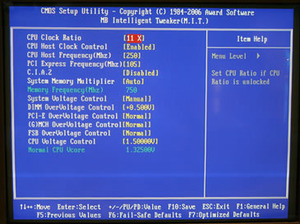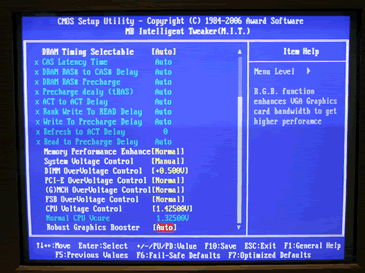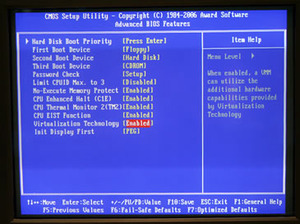Rear I/O Panel:

Gigabyte has dropped a second Gigabit Ethernet in favour of an arguably more useful Firewire socket. Without extending the rear I/O panel beyond ATX specification or losing something, there's little space to include anything extra. It seems that the motherboard engineers carefully thought out the best use of space and varied range of applications - we think they did a pretty good job.
BIOS:
Gigabyte uses a Phoenix AwardBIOS on the GA-965P-DQ6 - we used version F4 for our performance and stability testing. During our evaluation, Gigabyte released version F5 of the BIOS, which boasts enhanced overclocking capabilities. We tested the board again with the new BIOS and saw no differences in performance or stability - we will discuss overclocking later on.



BIOS Highlights:
- CPU Multiplier - from 6.0x to CPUMax (CPU dependant);
- CPU Host Frequency - 100MHz to 700MHz (1MHz increments);
- System Memory Multiplier - 2.0x, 2.5x, 2.66x, 3.0x, 3.5x and 4.0x;
- PCI-Express Frequency - 90MHz to 150MHz (1MHz increments);
- Memory Timing Adjustments (via CTRL+F1) - CAS, tRP, tRAS, tRCD, ACT to ACT and refresh ACT, tWtR, Write and Read Precharge delay;
- Memory Voltage - Normal, +0.025V to +0.775V (0.025V increments);
- PCI-Express Voltage - Normal, +0.05V to +0.35V (0.05V increments);
- MCH Voltage - Normal, +0.05V to +0.75V (0.05V increments);
- FSB Voltage - Normal, +0.05V to +0.35V (0.05V increments);
- CPU Voltage - 0.6875V to 2.375V (0.0625V increments).
Gigabyte continues to incorporate the annoying CTRL+F1 trick to show the memory timings, which we simply can't understand. Every other manufacturer includes them without having to do some cryptic button combo. When you're tweaking the performance, it's just another couple of buttons to have to press every single time.
What makes this CTRL+F1 requirement even stranger is the fact that Gigabyte allows users to put up to 2.375V through their CPU (likely to result in a very short life for the CPU subjected to this madness) without having to press it. In our opinion, adjusting memory timings isn't anywhere near as dangerous as supplying components with potentially death-inducing voltage options.
Apart from that rather strange decision, the GA-965P-DQ6's BIOS is generally pretty easy to use and well laid out, as is typical with most Phoenix AwardBIOS implementations. All we can say is be wary when you're adjusting the boards' voltages and take special care when changing the CPU voltage.

MSI MPG Velox 100R Chassis Review
October 14 2021 | 15:04









Want to comment? Please log in.